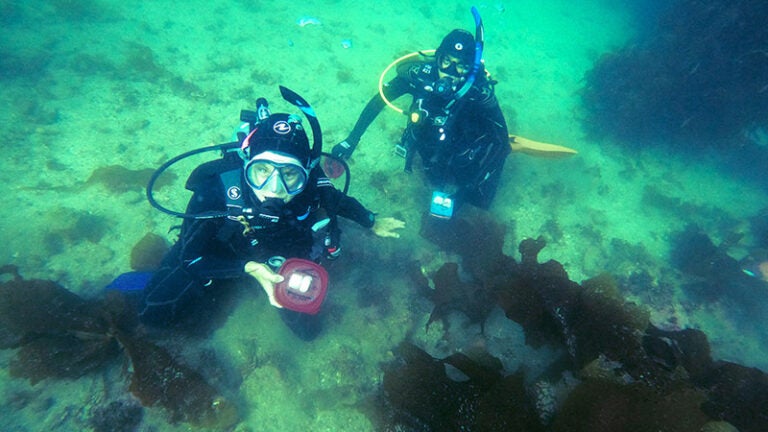
Summer at an island lab has undergraduates tackling questions about our oceans
At the USC Wrigley Marine Science Center on Santa Catalina Island off the coast of Los Angeles, Janell Segura is punching a nickel-sized hole from a slippery sheet of green kelp. Later, she’ll examine the specimen to make sense of how the seaweed reacts to light, so she can better understand its circadian rhythm.
Just beyond the lab’s windows lies the dark blue water of Fisherman’s Cove, dotted with bubbles from scuba divers. Beneath the surface, USC Dornsife College of Letters, Arts and Sciences environmental studies majors Erin Tharp and Vineet Bhandari are looking for sea cucumbers in the sandy bottom of the cove.

Erin Tharp discovered an interest in diving while in high school. (Photo: Inessa Chandra.)
After lab time and dives are complete, the students might hike off into the soft yellow hills that surround the facility, or go kayaking among the island’s coves as the sun sets.
All three students are participating in one of the USC Wrigley Institute for Environmental Studies’ research programs for undergraduates, living in the center’s dorms on the island campus for most of the summer and commuting just a few steps to the dock and labs. It’s a unique escape for students accustomed to USC’s bustling University Park campus.
“It’s so special to have this opportunity so close,” says Tharp. “We’re only 26 miles away from L.A., but it feels like we’re a million miles away.”
Diving deep
Tharp and Segura are part of the Summer Research Experience for Undergraduates (REU): Coastal Ocean Processes program. Funded by the National Science Foundation, participants spend nine weeks on the island conducting hands-on research, attending lectures and field trips and receiving mentorship from USC Dornsife faculty.
Her REU experience allowed Tharp to pursue her primary passion, scuba diving, which was sparked by a high school trip to Thailand, where she dove among coral beds.
“When you’re underwater, you feel one with nature instead of like an intruder,” says Tharp.
Arriving at USC Dornsife, she discovered USC Dornsife’s Scientific Diving Program and got certified.
Diving was also a draw for Bhandari, a Zinsmeyer Summer Undergraduate Research Program participant. He, too, completed USC Dornsife’s diving program and earned his certification during his fellowship this summer. He completed nearly 50 scientific dives, well over the 12 needed for his certificate.
“You don’t get that same experience when you’re just in the classroom. Once you go out [in the water], it’s a whole different immersive experience that you never imagined before,” he says.
Hunting cucumbers
While at the USC Wrigley Institute, both Bhandari and Tharp worked on creating a baseline population count for sea cucumbers and researched which conditions they find most favorable. These echinoderms are essential to maintaining healthy ocean ecosystems as they munch up bits of decaying material that drift to the sea floor.

Vineet Bhandari completed almost 50 scientific dives during his REU program. (Photo: Margaret Crable.)
The fellowship also gave Bhandari a chance to work on his underwater photography. He took his GoPro on dives, snapping photos of the divers and aquatic life beneath the surface. Bhandari believes that pictures are one of the best ways to get people interested in the natural world.
“I’m really interested in bridging the gap between the natural science research we’re doing out here and the social sciences. This is why I focused a lot on photography, so that we can better understand and address environmental challenges,” says Bhandari.
Kelp clocks
Some of the students’ research could have an impact on sustainability efforts. Segura, a biology major at Mt. Saint Mary’s University on L.A.’s westside, worked under USC Dornsife marine biology Ph.D. student Inessa Chandra as she examined kelp’s circadian clock. Segura had previously attended a class on ocean science at the USC Wrigley Institute co-led by one of her Mt. Saint Mary’s professors, who then recommended that Segura apply for the REU program.
Throughout the history of agriculture, farmers have unintentionally used the biological clock of crops to improve agricultural yields and cut down the use of resources such as water and pesticides. Knowing more about kelp’s inner workings can benefit projects like USC’s kelp elevator, which aims to cultivate the seaweed as a major biofuel source.

Janell Segura collects samples of kelp to use in her lab research. (Image: Courtesy of Jenell Segura.)
“We know some humans are morning people and others are night people. Does kelp also have these internal biological clocks?” ponders Chandra.
REU research doesn’t stop once summer ends. In 2015, alumna Audrey Looby, then an environmental studies major at USC Dornsife, conducted surveys of the biodiversity in the waters close to the USC Wrigley Center as part of her REU project.
Her work with David Ginsburg, professor (teaching) of environmental studies, was recently published in Western North American Naturalist and constitutes the most comprehensive study of species in the area ever completed. Summer on an island was perhaps never before so productive.